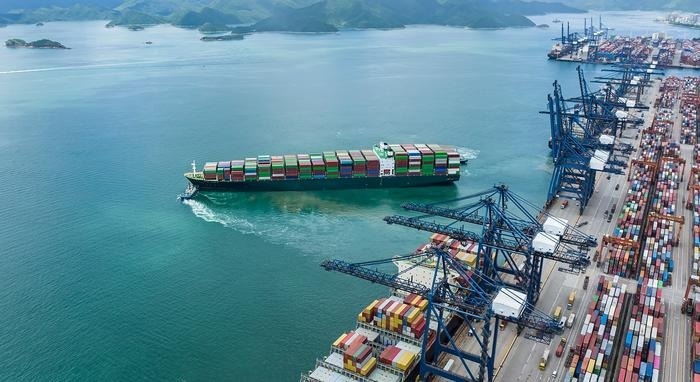A recent study, which was published in the journal Environmental Research: Infrastructure and Sustainability by IOP Publishing, discovered that by focusing only on the top 10 regional fuel ports, green ammonia could meet the fuel requirements of more than 60% of worldwide shipping.
 Ariel view of cargo container ships at port. Image Credit: IOP Publishing
Ariel view of cargo container ships at port. Image Credit: IOP Publishing
The production costs of ammonia are comparable to those of very low sulfur fuels. Thus, researchers at the University of Oxford came to the conclusion that the fuel would be a practical way to contribute to the decarbonization of international shipping by 2050.
By 2050, the switch to a green ammonia fuel supply chain will require about USD 2 trillion, mostly for supply infrastructure financing. According to the report, Australia has the greatest need for investment to supply the Asian markets.
Large production clusters are also expected to be located in Chile, which will supply South America; California, which will supply the West Coast of the United States; North-West Africa, which will supply Europe; and the southern Arabian Peninsula, which will supply parts of South Asia and local demand.
Around 90% of the physical trade in products worldwide is carried out by ships that release harmful emissions and burn heavy fuel oil. This constitutes around 3% of the worldwide output of greenhouse gases (GHGs). Consequently, the International Maritime Organization (IMO) made a commitment in 2018 to decarbonize global shipping with the goal of halving greenhouse gas emissions by 2050.
Recently, these goals were changed to achieve net zero emissions by 2050. Green ammonia, which is produced by electrolyzing water with renewable power, was suggested as an alternate fuel source to rapidly decarbonize the shipping industry after the practicality of diesel vessel exhaust scrubbers was examined.
But traditionally, there has been much uncertainty about where and how to spend to build the infrastructure required to provide a fuel supply chain that is both efficient and profitable.
Shipping is one of the most challenging sectors to decarbonize because of the need for fuel with high energy density and the difficulty of coordinating different groups to produce, utilize and finance alternative (green) fuel supplies.
René Bañares-Alcántara, Professor, Chemical Engineering, Department of Engineering Science, University of Oxford
The University of Oxford team created a modeling framework to generate realistic scenarios for how to set up a worldwide green ammonia fuel supply chain, which will serve as guidance for investors. The framework finds the optimal places to meet future shipping fuel demand by combining a fuel demand model, future trade scenarios, and a spatial optimization model for green ammonia production, storage, and delivery.
Bañares-Alcántara continues, “The implications of this work are striking. Under the proposed model, current dependence upon oil-producing nations would be replaced by a more regionalized industry; green ammonia will be produced near the equator in countries with abundant land and high solar potential and then transported to regional centers of shipping fuel demand.”
Journal Reference:
Verschuur, J., et al. (2024) Optimal fuel supply of green ammonia to decarbonise global shipping. Environmental Research: Infrastructure and Sustainability. doi.org/10.1088/2634-4505/ad097a.